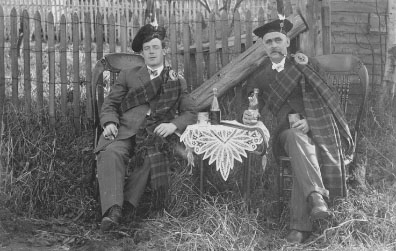Scotch Ale is a traditional, top-fermented beer that is brewed to greatly varying strengths. Sometimes the term “Scotch ale” is reserved just for the heavier versions, while the milder versions are labeled “Scottish ales.” Traditionally, the different versions of Scotch ale were classified by a nomenclature that is derived from their per-barrel price in the 19th century, in increments of 10 shillings from 60 to 160 shillings.

Two men enjoying strong Scotch Ale, also known as “Wee Heavy,” c. 1890. pike microbrewery museum, seattle, wa
The base malt for Scotch ale is pale ale malt with varying amounts of pale caramel malt and unmalted roasted barley added to the mash. Many homebrewers and craft brewers, particularly in the United States, have taken to adding peat-smoked malts to their Scotch ales, perhaps influenced by the peaty character of Scotch whiskies. Although Scottish malts were traditionally floor-malted and then dried or roasted in peat-fired kilns, giving the malts smoky flavors, malts were once dried over fires almost everywhere; Scottish beers were no smokier than others. Scottish brewers got rid of smoked malts as soon as brewers in other countries; modern Scottish brewers and historians insist that there’s nothing “Scottish” about beers with peat flavors. Despite these protests, the romance is hard to cast aside, and modern brewers sometimes imitate this fanciful flavor by adding to the mash a small portion of peat-flavored whiskey malt or even a small percentage of Rauchbier-type smoked malt.
The color of Scotch ale ranges from amber, to light brown, to deep mahogany. Scotch ale is often mashed-in thick for a saccharification rest of 60 to 90 minutes at a single, relatively high temperature of 158°F (70°C) or above, which favors alpha-amylase instead of beta-amylase activity. This generates a good amount of higher-molecular, unfermentable sugars, which provide body and mouthfeel to the finished beer as well as a rich maltiness.
Traditionally, Scotch ales of differing strengths were brewed by the parti-gyle method, whereby the strong ales were collected just from the first runnings of the mash and boiled and fermented separately.
Scotch ales are top-fermented, but in the cool climates of Scotland, fermentations carried out at ambient temperatures have rarely been very warm, and as a result, levels of fruity esters tend to be low. For the same reason, stronger Scotch ales have traditionally had more residual sugar than their counterparts to the south. Bitterness levels of Scotch ales range widely, usually between 15–25 IBU, but hops have never been a focal point of beers brewed in a land where hops will not grow. Scotch ale aromatics tend toward rich maltiness, with hop character kept very much in the background.
While Scottish brewers may never have had a predilection for peat flavors, they did often use flowers and herbs in their beer before the introduction of hops (imported from warmer, sunnier England), in the 19th century. Use of heather in particular was once quite common. Without the protective qualities of the hop, however, these beers often spoiled quickly, and one wonders whether this pushed the Scots in the direction of their more famous whiskies. That said, the stronger Scotch ales, especially the rich “wee heavies,” have long enjoyed an excellent reputation, not only at home but also in the export trade.
